Observations at Succulent Gardens Nursery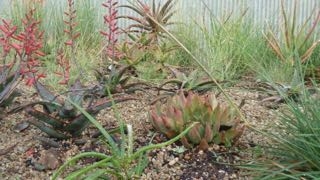
Three months into the yearlong internship I did at Succulent Gardens in Castroville and I was mesmerized. Succulent Extravaganza is an annual event for this nursery, and in 2014 a dozen or so sample gardens were newly installed by different garden designers for demonstrating the use of succulents in the landscape. Robin Stockwell, who established Succulent Gardens and is a great supporter of the UC Master Gardener program, invited Master Gardeners who could commit to a year of observations and reporting on these gardens. We were to observe the success and/or failure of the plants and the design. This is a brief summary of what I monitored over the year in one of the gardens I was assigned, John Greenlee's Grass Garden.
Within the grass garden, a staggering amount of plant material was put into the native, sandy soil. The large site was oriented along the back of a greenhouse on a slight slope with a strong east and south exposure. I rapidly noted the plants used on my roughly drawn layout as John Greenlee was finishing up his plantings in this garden just before the extravaganza opened. John is a well-respected, internationally known ornamental grass expert and has installed grass gardens/meadows at such notable places as the J. Paul Getty Museum and Disney's Animal Kingdom Park at Disney World. John talked about some of the grasses he had selected, mostly species rather than hybrids. There were also a variety of cool and warm season grasses, as I would come to witness with the changing seasons.
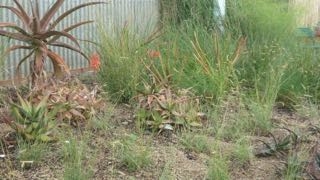
Other than rainfall, the only irrigation this garden received was the initial few weeks of sprinkler and hand watering until the plants were established. This, however, with the sparse gravel ground cover produced a voluminous amount of weeds. Many of the grasses were plugs and the succulents were smaller, leaving a lot of open ground. But fill in quickly they did.
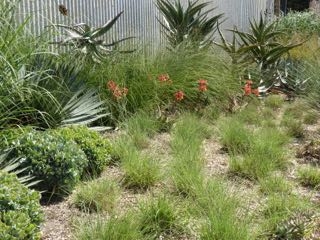
Over the course of the year on my visits I noted weather conditions and roughly what, if any, precipitation had fallen, as well as any especially hot/dry or chilling/freezing events. With the exception of one good downpour in December, creating some erosion problems, it was a dry and mild winter. Despite this gentle climate, I noticed decline in some of the smaller Aloe hybrids, and although the leaves looked poorly, the plants could still flower fully and for a long time. The one succulent that put on an endurance run of flowering was Bulbine frutescens, stalked bulbine, a South Africa native, blooming bright yellow for over six months. The only pest problems encountered were aphids in the flowers of the Echeverias, the Sedums, some of the smaller Aloes and one of the Aloe ‘Hercules.'
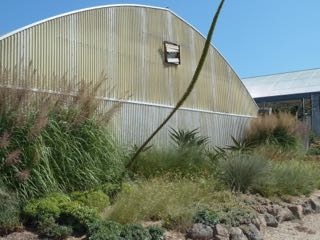
Variety Adds Interest
Succulents in most domestic gardens may consist of a few pots, a small patch, or maybe a narrow planting strip. The thing that I especially enjoyed about this garden of mixed succulents, grasses and bulbs, and the way it was laid out, is that I could both visually and physically wander around and be surprised. I might encounter a blooming succulent that from another angle may have been obscured by cascading blades of grass, or the statuesque quality of a large tree aloe being softened by the tall grasses around it. Every time I visited this garden I found something delightful about it in the way it changed with the seasons.
As coincidence would have it, at the time I started watching this garden, I had recently moved some of my native red fescue grass (Festuca rubra ‘Molate') and poppies into a four-foot wide strip of succulents at the front of my yard. It was interesting to contrast and compare the two gardens as the year progressed. Although many succulents fare better with some shade, I found that in my own small patch as the grass and poppies reached their mature size, they shaded out too many of the near-by succulents.
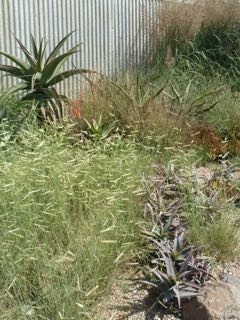
There are many ways to create interest with succulents, grasses, perennials and annuals that share similar soil, exposure and irrigation needs.
- Plant succulents in pots of varying heights and diameters and place them within a site containing ornamental grasses.
- Create a rock garden with succulents at the edge of a drought tolerant perennial bed with some added ornamental grasses.
- Choose succulents that will cascade down a retaining wall with native perennials and grasses behind it.
I enjoy playing around with scale, texture, pattern, color, and density of plants. Succulents are highlighted especially well when interspersed with rocks and gravel of varying size. Perhaps, like me, you find succulents are a bit of an obsession and that they may keep you occupied and happy for a long time.